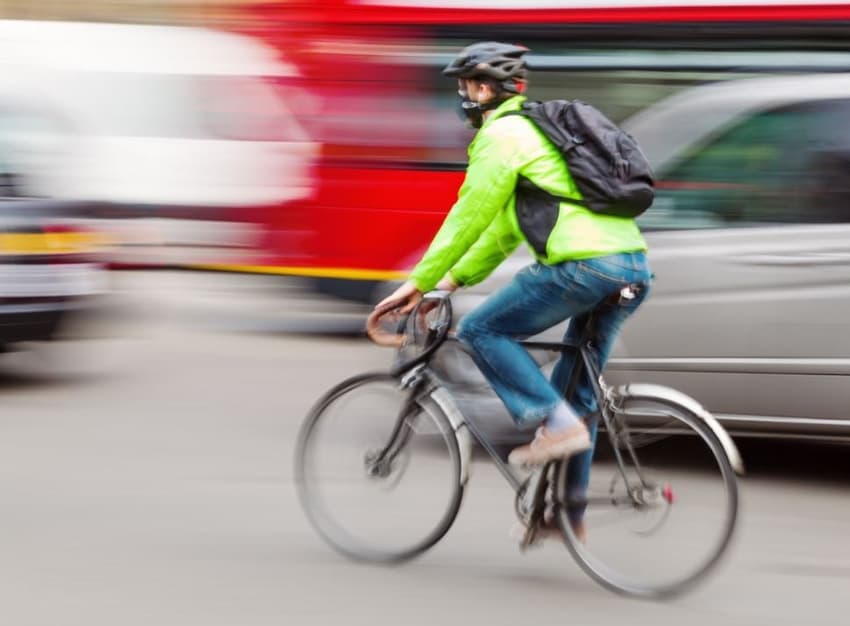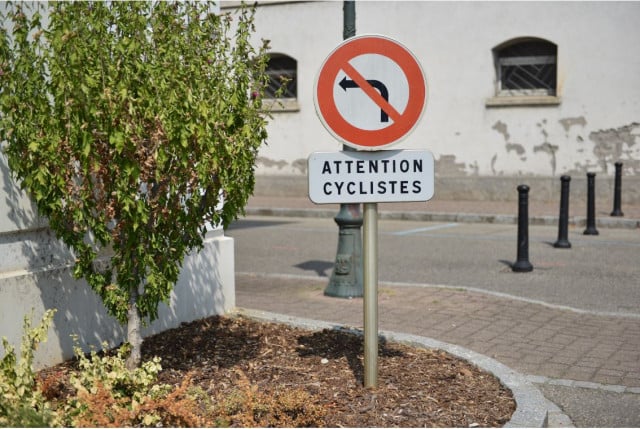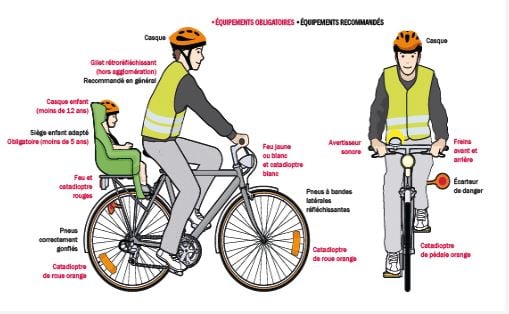bike
For Members
How to avoid being hit with fine when cycling in French cities

It's not easy staying on the right side of the myriad French laws concerning cycling - as Paris' deputy mayor recently found out when he was fined for wearing earphones.
Deputy Paris mayor Emmanuel Gregoire later sheepishly confessed on Twitter that he didn't know about the new rule making cyclists liable for a €135 fine for riding while wearing an audio headset.
So, bearing in mind that even the politicians can't keep up, what do cyclists need to do to stay out of trouble on French roads?
READ ALSO The 10 best places to cycle in France
 (Paris deputy mayor Emmanuel Gregoire fell foul of French cycling laws. Photo: AFP)
The basics
When cycling in France remember to make sure that your bike is properly equipped.
If cycling at night it must have a white light at the front and a red one at the back and pedals with orange reflectors. If you are caught with no lights you are liable to pay a €33 fine.
You also need to remember that when cycling at night (and when visibility is bad) you should really wear a high visibility vest and should avoid cycling two abreast.
Also you are supposed to be equipped with a decent bell, that can be heard 50 metres away. This is also potentially punishable by a €33 fine.
And don't use your mobile phone and cycle at the same time or you could be fined €90.
No earphones
Since July 2015, using headphones when cycling has been banned due to the fact that an audio headset cuts the cyclist off from their environment and is a distraction when on the roads.
"We are the only country to make it an offense," Charles Maguin, president of the association Paris en Selle, a cycling organisation in the French capital, told the French press.
Meanwhile, cyclists can wear audio headsets in the case of hearing aids and emergency vehicles.
Priorité à droite
One of the most complicated parts of cycling in a foreign country can be knowing which signs apply to you and, of course, what they mean.
One of the most important ones for you to remember, explains Jon Lethbridge from Loire Life Cycling, is the red triangle with a cross which appears when you are approaching a junction.
(Paris deputy mayor Emmanuel Gregoire fell foul of French cycling laws. Photo: AFP)
The basics
When cycling in France remember to make sure that your bike is properly equipped.
If cycling at night it must have a white light at the front and a red one at the back and pedals with orange reflectors. If you are caught with no lights you are liable to pay a €33 fine.
You also need to remember that when cycling at night (and when visibility is bad) you should really wear a high visibility vest and should avoid cycling two abreast.
Also you are supposed to be equipped with a decent bell, that can be heard 50 metres away. This is also potentially punishable by a €33 fine.
And don't use your mobile phone and cycle at the same time or you could be fined €90.
No earphones
Since July 2015, using headphones when cycling has been banned due to the fact that an audio headset cuts the cyclist off from their environment and is a distraction when on the roads.
"We are the only country to make it an offense," Charles Maguin, president of the association Paris en Selle, a cycling organisation in the French capital, told the French press.
Meanwhile, cyclists can wear audio headsets in the case of hearing aids and emergency vehicles.
Priorité à droite
One of the most complicated parts of cycling in a foreign country can be knowing which signs apply to you and, of course, what they mean.
One of the most important ones for you to remember, explains Jon Lethbridge from Loire Life Cycling, is the red triangle with a cross which appears when you are approaching a junction.
 (Pay attention to road signs. Photo Depositphoto)
It means that you must give priority to the right -- “priorité à droite”, which is one of the foundations of France's rules of the road and means cars arriving from the right at an intersection have right-of-way.
In short: If you're driving and there's a vehicle trying to join or cross the road to your right, then you're obliged to let them in.
But this is made more complicated by the fact that sometimes you don't actually have to give way to the right.
In fact, some French junctions won't have stop signs nor traffic lights and are governed entirely by this principle. So it's generally a good idea to take it slow through any uncontrolled intersection in France.
"Sometimes drivers will let cyclists go first but this can really depend on which department you're in and can be a bit hit and miss," Lethbridge says.
"Take it steady and catch the eye of the driver to get an idea of what they're going to do," he adds.
Can you run a red light?
You can't ignore a red light unless a "give way" sign is attached. The signs are accompanied with an arrow showing cyclists which way they go if they go through the red light.
The rule, which was brought in in July 2015, means that cyclists can carry straight on or turn right or left without waiting for red, although it will depend on each intersection.
And of course, you need to make sure that you're not about to get run over by a car coming from a different direction or by pedestrians running across the road.
Sauf vélo
Another important sign for you to familiarise yourself with is the 'sauf vélo' (except bikes) signs which you'll see dotted around villages and towns.
These are there to let you know that even though other vehicles can't go down that street -- for example if it's a one-way street -- bikes can.
Walk across bridges
Make sure you keep an eye out for the "vélo a main" (literally "bike in hand") which often appear at bridges in small towns.
This means you should dismount and walk your bike over the bridge using the pavement.
Helmets
Wearing a helmet is not compulsory for adults when cycling in France, but it is for children under 12-years-old both when they're cycling and when they're being carried as a passenger.
For adults accompanying children who are not wearing a helmet, there's a €135 fine.
"It's not as common for adults in France to wear a helmet when they're on a bike," says Lethbridge. "It's far more common to see Brits, Australians and Canadians wearing them."
(Pay attention to road signs. Photo Depositphoto)
It means that you must give priority to the right -- “priorité à droite”, which is one of the foundations of France's rules of the road and means cars arriving from the right at an intersection have right-of-way.
In short: If you're driving and there's a vehicle trying to join or cross the road to your right, then you're obliged to let them in.
But this is made more complicated by the fact that sometimes you don't actually have to give way to the right.
In fact, some French junctions won't have stop signs nor traffic lights and are governed entirely by this principle. So it's generally a good idea to take it slow through any uncontrolled intersection in France.
"Sometimes drivers will let cyclists go first but this can really depend on which department you're in and can be a bit hit and miss," Lethbridge says.
"Take it steady and catch the eye of the driver to get an idea of what they're going to do," he adds.
Can you run a red light?
You can't ignore a red light unless a "give way" sign is attached. The signs are accompanied with an arrow showing cyclists which way they go if they go through the red light.
The rule, which was brought in in July 2015, means that cyclists can carry straight on or turn right or left without waiting for red, although it will depend on each intersection.
And of course, you need to make sure that you're not about to get run over by a car coming from a different direction or by pedestrians running across the road.
Sauf vélo
Another important sign for you to familiarise yourself with is the 'sauf vélo' (except bikes) signs which you'll see dotted around villages and towns.
These are there to let you know that even though other vehicles can't go down that street -- for example if it's a one-way street -- bikes can.
Walk across bridges
Make sure you keep an eye out for the "vélo a main" (literally "bike in hand") which often appear at bridges in small towns.
This means you should dismount and walk your bike over the bridge using the pavement.
Helmets
Wearing a helmet is not compulsory for adults when cycling in France, but it is for children under 12-years-old both when they're cycling and when they're being carried as a passenger.
For adults accompanying children who are not wearing a helmet, there's a €135 fine.
"It's not as common for adults in France to wear a helmet when they're on a bike," says Lethbridge. "It's far more common to see Brits, Australians and Canadians wearing them."
 (There are strict rules for passengers on bikes. Diagram: French government website)
No riding on pavements...
If you're tempted to avoid traffic by swerving onto the pavement don't - only children under eight are allowed to do that.
And what about pedestrianised areas?
You can cycle in these areas but obviously it's important to remain considerate of the people walking there and adjust your speed accordingly. This is detailed in Article R431-9 of the Highway Code.
This section of the code also covers whether or not you can decide not to use designated bike paths.
The rules on this vary in different parts of France and it is up to local police authorities to decide how they manage it. In some places, there will be signs indicating what you should do -- if a bike path sign is square, you can choose not to use the bike path and if it is round, using it is obligatory.
What to do if you have passengers?
Do not carry a passenger except on a seat attached to the bicycle and if the passenger is under 5 years old, the seat must be equipped with footrests and straps, and as mentioned the child must be wearing a helmet.
(There are strict rules for passengers on bikes. Diagram: French government website)
No riding on pavements...
If you're tempted to avoid traffic by swerving onto the pavement don't - only children under eight are allowed to do that.
And what about pedestrianised areas?
You can cycle in these areas but obviously it's important to remain considerate of the people walking there and adjust your speed accordingly. This is detailed in Article R431-9 of the Highway Code.
This section of the code also covers whether or not you can decide not to use designated bike paths.
The rules on this vary in different parts of France and it is up to local police authorities to decide how they manage it. In some places, there will be signs indicating what you should do -- if a bike path sign is square, you can choose not to use the bike path and if it is round, using it is obligatory.
What to do if you have passengers?
Do not carry a passenger except on a seat attached to the bicycle and if the passenger is under 5 years old, the seat must be equipped with footrests and straps, and as mentioned the child must be wearing a helmet.
Comments (2)
See Also
Deputy Paris mayor Emmanuel Gregoire later sheepishly confessed on Twitter that he didn't know about the new rule making cyclists liable for a €135 fine for riding while wearing an audio headset.
So, bearing in mind that even the politicians can't keep up, what do cyclists need to do to stay out of trouble on French roads?
READ ALSO The 10 best places to cycle in France

(Paris deputy mayor Emmanuel Gregoire fell foul of French cycling laws. Photo: AFP)
The basics
When cycling in France remember to make sure that your bike is properly equipped.
If cycling at night it must have a white light at the front and a red one at the back and pedals with orange reflectors. If you are caught with no lights you are liable to pay a €33 fine.
You also need to remember that when cycling at night (and when visibility is bad) you should really wear a high visibility vest and should avoid cycling two abreast.
Also you are supposed to be equipped with a decent bell, that can be heard 50 metres away. This is also potentially punishable by a €33 fine.
And don't use your mobile phone and cycle at the same time or you could be fined €90.
No earphones
Since July 2015, using headphones when cycling has been banned due to the fact that an audio headset cuts the cyclist off from their environment and is a distraction when on the roads.
"We are the only country to make it an offense," Charles Maguin, president of the association Paris en Selle, a cycling organisation in the French capital, told the French press.
Meanwhile, cyclists can wear audio headsets in the case of hearing aids and emergency vehicles.
Priorité à droite
One of the most complicated parts of cycling in a foreign country can be knowing which signs apply to you and, of course, what they mean.
One of the most important ones for you to remember, explains Jon Lethbridge from Loire Life Cycling, is the red triangle with a cross which appears when you are approaching a junction.
(Pay attention to road signs. Photo Depositphoto)
It means that you must give priority to the right -- “priorité à droite”, which is one of the foundations of France's rules of the road and means cars arriving from the right at an intersection have right-of-way.
In short: If you're driving and there's a vehicle trying to join or cross the road to your right, then you're obliged to let them in.
But this is made more complicated by the fact that sometimes you don't actually have to give way to the right.
In fact, some French junctions won't have stop signs nor traffic lights and are governed entirely by this principle. So it's generally a good idea to take it slow through any uncontrolled intersection in France.
"Sometimes drivers will let cyclists go first but this can really depend on which department you're in and can be a bit hit and miss," Lethbridge says.
"Take it steady and catch the eye of the driver to get an idea of what they're going to do," he adds.
Can you run a red light?
You can't ignore a red light unless a "give way" sign is attached. The signs are accompanied with an arrow showing cyclists which way they go if they go through the red light.
The rule, which was brought in in July 2015, means that cyclists can carry straight on or turn right or left without waiting for red, although it will depend on each intersection.
And of course, you need to make sure that you're not about to get run over by a car coming from a different direction or by pedestrians running across the road.
Sauf vélo
Another important sign for you to familiarise yourself with is the 'sauf vélo' (except bikes) signs which you'll see dotted around villages and towns.
These are there to let you know that even though other vehicles can't go down that street -- for example if it's a one-way street -- bikes can.
Walk across bridges
Make sure you keep an eye out for the "vélo a main" (literally "bike in hand") which often appear at bridges in small towns.
This means you should dismount and walk your bike over the bridge using the pavement.
Helmets
Wearing a helmet is not compulsory for adults when cycling in France, but it is for children under 12-years-old both when they're cycling and when they're being carried as a passenger.
For adults accompanying children who are not wearing a helmet, there's a €135 fine.
"It's not as common for adults in France to wear a helmet when they're on a bike," says Lethbridge. "It's far more common to see Brits, Australians and Canadians wearing them."
(There are strict rules for passengers on bikes. Diagram: French government website)
No riding on pavements...
If you're tempted to avoid traffic by swerving onto the pavement don't - only children under eight are allowed to do that.
And what about pedestrianised areas?
You can cycle in these areas but obviously it's important to remain considerate of the people walking there and adjust your speed accordingly. This is detailed in Article R431-9 of the Highway Code.
This section of the code also covers whether or not you can decide not to use designated bike paths.
The rules on this vary in different parts of France and it is up to local police authorities to decide how they manage it. In some places, there will be signs indicating what you should do -- if a bike path sign is square, you can choose not to use the bike path and if it is round, using it is obligatory.
What to do if you have passengers?
Do not carry a passenger except on a seat attached to the bicycle and if the passenger is under 5 years old, the seat must be equipped with footrests and straps, and as mentioned the child must be wearing a helmet.
Join the conversation in our comments section below. Share your own views and experience and if you have a question or suggestion for our journalists then email us at [email protected].
Please keep comments civil, constructive and on topic – and make sure to read our terms of use before getting involved.
Please log in here to leave a comment.